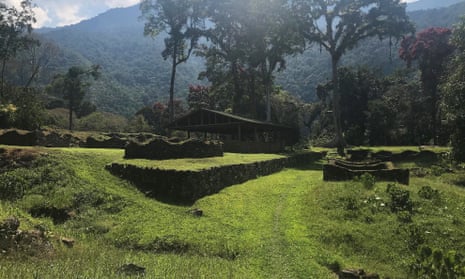Jorge Cobos follows the remnants of an Inca road down the eastern slopes of Peru’s Andes, through cloud forest and over swaying plank bridges, edging along narrow paths beside sheer drops.
Finally, after a four-day trek, he clears a patch of undergrowth with his machete, revealing a moss-covered wall. Thick roots are entwined around fallen lintels. Elsewhere, the stonework is still daubed with orange plaster.
“Imagine – there are lots of buildings left to discover in the forest,” he said. “And beyond, in the mountains: who knows?”
The sprawling ruins are, scholars agree, the last capital of Vilcabamba: a holdout Inca state that resisted for decades after the conquistadors landed in Peru in 1532, executed the emperor Atahualpa, and occupied the Inca capital of Cusco.
Forgotten for centuries, the city of Espíritu Pampa – also known as Old Vilcabamba – has only been cleared in recent decades.
And the latest findings, a new site museum and fieldwork both scheduled for 2019 – along with the pending completion of a road through Vilcabamba – are bringing attention to the last stronghold of the Incas once more.
Architect and explorer Vincent Lee first mapped out Espíritu Pampa in detail in the 1980s, when the region was under the control of brutal Shining Path guerrillas.
“It was a step back into the 19th century just to go there – and a potentially dangerous one,” he said.
The jungle “was so thick one could hardly see one building from the next,” Lee added.
Today, three government workers use machetes to keep the foliage at bay from a palace compound, the remains of a huge hall with 26 doorways, and a labyrinth of rooms, streets and stairways.
“The area is fascinating because it still hasn’t been disturbed or looted. The information is firsthand,” said Javier Fonseca, an archaeologist with Peru’s ministry of culture.
“It’s the last capital of Inca resistance,” he added. “It has history, it has archaeology, it has everything. It’s genuinely a marvel to work in this place.”
Four successive Incas ruled in Vilcabamba, venerating the sun, engaging in diplomacy and guerrilla warfare with the Spanish – and inspiring rebellions beyond their mountain refuge.
Facing an overwhelming invasion in 1572, the Incas set the city ablaze and fled into the forest. The Spanish captured Peru’s last indigenous monarch Túpac Amaru I and executed him in Cusco, bringing the Inca empire to an end. Espíritu Pampa was swallowed up by the jungle.

Yet recent research points to a far older origin for the site – and to a web of connections linking Vilcabamba with its European and indigenous neighbours.
Archaeologists Brian Bauer and Miriam Araoz have documented metal nails, roof tiles and pairs of scissors. Their excavations have shed further light on Yuraq Rumi – a monumental rock expertly carved with steps, shelves and bulges, centrepiece of an Inca shrine near Vitcos.
In one sector of Espiritú Pampa – dominated by towering matapalo trees that grip the ruins – Fonseca pieced together a unique ceramic vessel depicting Andean and Amazonian peoples, backed up by jaguars, united in battling the mounted conquistadors.
Perhaps the most intriguing discoveries at Espíritu Pampa concern the Wari – a predecessor culture to the Inca that ruled swaths of Peru between 600 and 1100AD.
In 2010, Fonseca identified a sumptuous Wari burial complex near the main site. One occupant – dubbed the Lord of Wari – was found with a silver mask, breastplate, axe blades and ornaments, golden bracelets and dozens of finely crafted vessels.
And late in 2017, Fonseca identified a Wari temple nearby, containing both Inca and Wari gold and silverwork.
“This society doesn’t disappear overnight. Part of the Wari inheritance survives, thanks to the Incas,” he argued.
These cross-cultural finds are currently divided between minor exhibits and storage units, Fonseca lamented, but there are plans to build a museum in Vilcabamba in 2019.

The Cobos family would like to see it established in Huancacalle, the small village by Vitcos from where explorers have long set out on foot for Espíritu Pampa.
But some fear this buccaneering tradition is coming to a close. Archaeologists are currently mapping the Inca path – to avoid any damage from a highway due to be extended into the valley below.
The new road is eagerly awaited by some Vilcabamba residents, mainly Quechua-speaking smallholders who barter potatoes, yuca, coffee and cuy (guinea pigs) to get by.
Even if it becomes more accessible, the last city of the Incas will still inspire wonder, and new techniques such as Lidar mapping may soon reveal the true extent of the city beneath the forest canopy.
“I’m sure there’s a great deal more to uncover,” said writer and explorer Hugh Thomson.
Benjamín Cobos, 90, agreed. As a boy, the Machiguenga peoples that lived at Espíritu Pampa told him of yet another city, even deeper in the forest.
“They said you have to walk for five days, along a wide Inca road,” he added. He once followed a barefoot indigenous guide, scrambling up densely wooded slopes for hours.
“But, because I didn’t care about ruins then, I turned back.”
